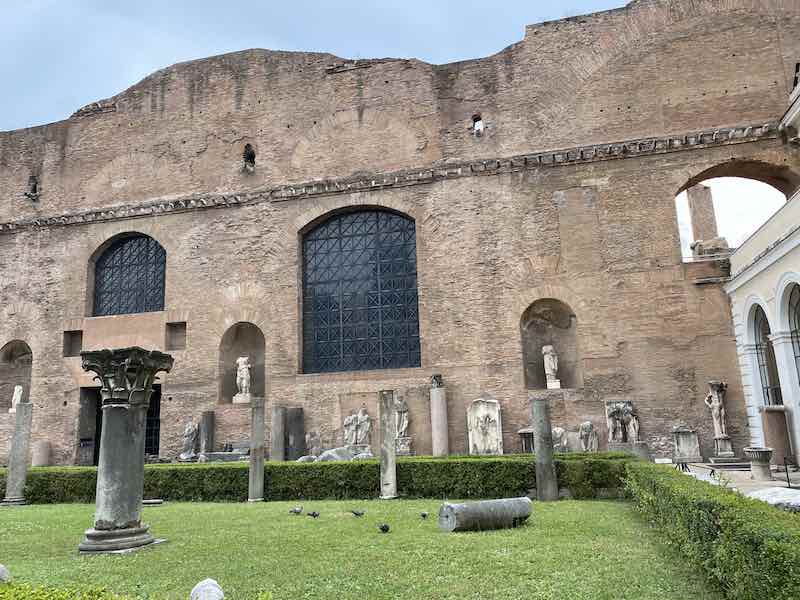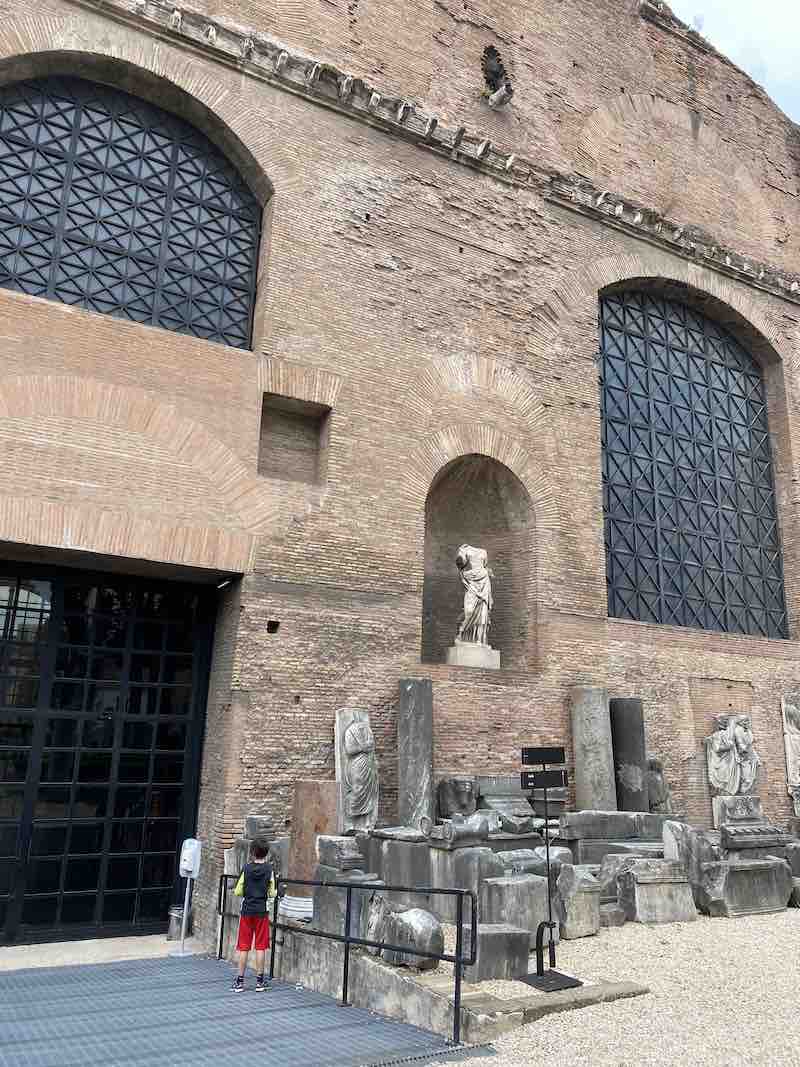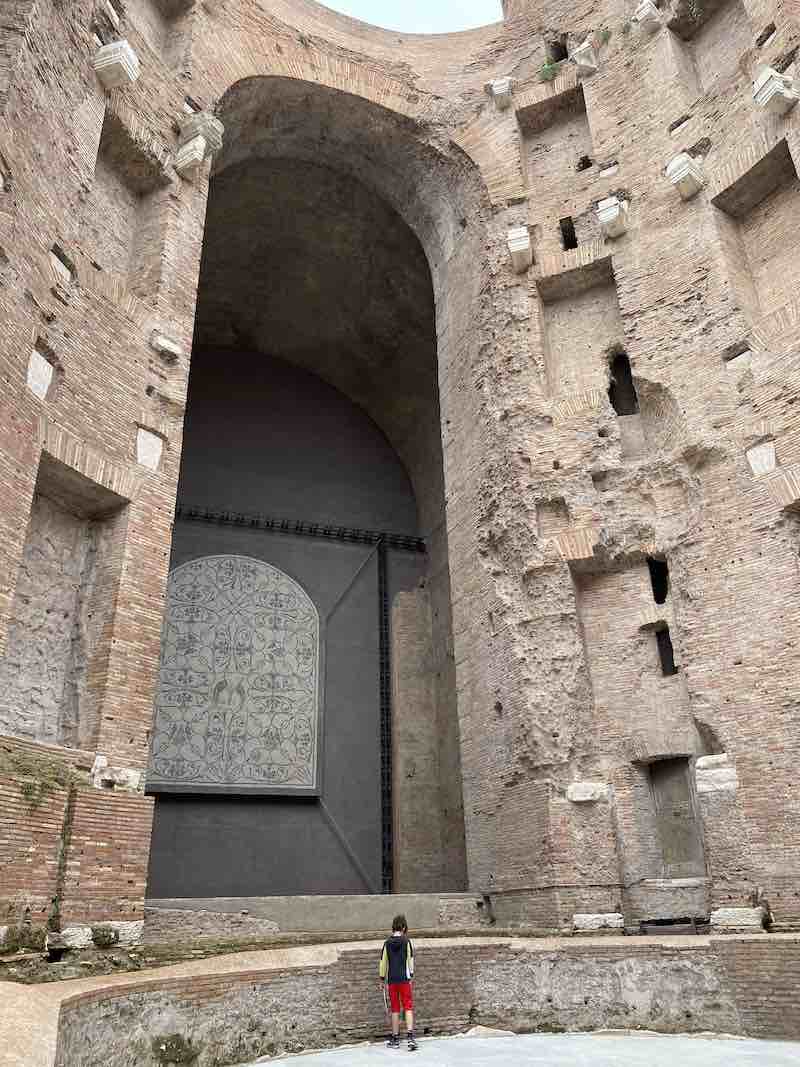All you need to know about the Baths of Diocletian in Rome: what they are, what makes them significant and how to visit.
The Baths of Diocletian are a colossal ancient thermal complex in Rome’s city center.
Build by order of Emperor Diocletian in the III century AD, the baths were the bigger in the ancient world, at the time of construction, and they an impressive sight to see.

Over the centuries, the building operated as thermal baths, a church, a monastery, a storage area and a Planetarium.
Now, the Baths of Diocletian are one of the seats of the Roman National Museum and a stunning archaeological site in Rome.
Only relatively recently open to the public, the Baths are less visited than other monuments in Rome but they are so beautiful to deserve the lake of Rome hidden gem.
This is all you need to know to plan a visit.
What are the Baths of Diocletian?
The Baths of Diocletian are a colossal thermal bath in Rome dating to the III century AD.
The construction lasted eight years, between 298 and 306 AD and take their name from Emperor Diocletian, during whose empire the baths got built and to whom they were dedicated.
Diocletian’s Baths are unique. They are among the biggest ancient thermal baths in the world and there are mostly intact.
When visiting, it is still possible to admire the giant vaulted ceilings of many of the chambers and it is possible to walk into the natatio, the ancient swimming area.
The baths occupy a surface of 13 hectares and they were able to hold up to 3000 people.
The baths stayed in use until the VI century and were then abandoned for about one thousand years.
Then, in 1561, Pope Pius IV decided to reuse the space and put Michelangelo in charge of turning them into a church and a monastery.
The church is called Santa Maria Degli Angeli e dei Martiri and it is still nowadays one of the most beautiful churches in Rome, for the mix of ancient spaces and Renaissance decor.
The church occupies what used to be the tepidarium and part of the natatio while the monastery occupied the northernmost part of the baths.
During a visit to the Baths of Diocletian, it is possible to visit the ancient baths and the cloisters of the monastery while the church is still in use and access is, therefore, free.

How to visit the Baths of Diocletian
Visiting the Baths of Diocletian is easy.
The site is part of the Roman National Museum and you can get tickets online from the >>> official website of the museum <<< Special discounts are available for holders of the MIC card (residents only).
At your own pace, the visit takes about 1 hour: it includes the museum’s area, which holds fascinating inscriptions, the cloisters of the monastery, that are now exhibition spaces of the museum, the front garden and several of the baths chambers.
Booking is recommended: in 2021 access is subject to temperature checks. A hand gel dispenser is at the entrance; the use of face masks is compulsory.
The Baths of Diocletian are in front of Termini Station and you can reach them by Metro A and B (Termini stop), metro stop Repubblica or any bus stopping at Termini.
The main entrance is just in front of the Termini station entrance, on the other side of the road, on Piazza dei Cinquecento.
What is it like to visit the Baths of Diocletian in Rome Italy
Visiting the Baths of Diocletian in Rome is a pleasant experience and a must-do for ancient history lovers.
On arrival, you first cross a pretty yard that opens onto the main ticket office and that you will have the chance to visit at the end of the tour.
Once inside, you encounter several areas that I find helpful to summarise as divided into four parts:
- The museum
- The big cloister
- The small cloister
- The baths

The museum
The first area you encounter is the museum. This part of the Rome National Museum is devoted mainly to inscriptions and it is fascinating to visit.
Good info panels explain why and how inscriptions were used in Ancient Rome and while the explanations are not extensive, there are sufficient info panels to understand what you are seeing even without paying for a guide.
The museum develops indoors (please be advised that parts of it are closed in 2021 due to health reasons) and around the two Renaissance cloisters.
They are usually called Chiostro Grande (Big Cloister or also Michelangelo’s Cloister) and Chiostro Piccolo
Michelangelo’s cloister
Michelangelo’s Cloister is one of the biggest in Italy and was the main cloister area of the monastery.
The cloister is based on a design by the artist and built after his death between 1565 and1676.
The cloister has a large green area in the center with beautiful shrubs and a fountain.
It hosts several beautiful statues and an eye-catching tromp l’oeil by Filippo Balbi (1885), representing father Certosino Fercoldo with objects recalling the daily life of the monks in the monastery.
Worth noticing are also the cypress trees around the fountain, one of which is centuries old and called ‘Michelangelo’s cypress’ and the colossal statues of animals also preserved in the gardens.

The small cloister
The second cloister is much smaller and occupied part of the area that used to host the ancient natatio of Diocletian’s times.
The cloister has a well in its center and it is reminiscent of cloisters you may see in Florence and Tuscany, with pretty small columns and cream coloured walls.
The small cloister hosts interesting documents about Rome’s ancient religion beautifully displayed and explained and used to host marbles from the Ludovisi collection, now moved to Palazzo Altemps, another seat of the museum.
These marbles are the reason why the cloistered is often referred to as the Ludovisi Cloister.

The baths of Diocletian as we see them today
The Baths of Diocletian used to occupy a vast area comprising the baths themselves with the hot, lukewarm and cold pools, as well as many common areas for study and exercise.
Where we now see Piazza della Repubblica, there used to be two exedras with libraries and two circular gyms, one of which is still largely visible.
The central part of the baths had the three bathing areas typical of the Roman thermal tradition, the calidarium, the tepidarium and the frigidarium, as well as the colossal natatio that are breathtaking.

During the visit to Diocletian’s baths, we can still appreciate some of these structures and in particular Aula X, aula XI.
Aula X used to one of the colossal entrances to the baths. It is a vast and excellently preserved room that now hosts the remarkable sepulchral monument to the Platorini, found along the river Tiber.
The room is stunning: here, you can appreciate the size of the building and marvel at its incredible, still standing, vaulted ceilings.
Aula XI is beside Aula X and now hosts a beautiful mosaic. It is not clear what use this room would have had in ancient times however, there is a hypothesis that it may have been a changing room.
Aula VIII now hosts several decor items from the thermal complex and used to open on the large natatio. This area would have looked like scenes from a theatrical backdrop, cladded with colorful marbles reflecting into the water and decorated with statues.
While we cannot fully appreciate what it would have looked like, it is still possible to admire the size and ambition of the project walking along the Aula and the natatio.
For reference, if you are familiar with other baths in Rome, this facade alone would have been twice as big as that of Caracalla’s Baths.
The walk along the natatio is very impressive and, in my opinion, the highlight of this visit.
Aula Ottagona: Aula Ottagona aka Octagonal Room was a large space with an interesting history: used as a storage area for grain in the XVII century, it was then turned into a planetarium, then dismantled in 1987.
Access to this room was not allowed at the time of our visit but you can appreciate its size and structure from the outside.
Visiting the Baths of Diocletian with kids
I have visited the Baths of Diocletian with my two children and found the baths to be kid-friendly.
While there is nothing in the museum for them (no interactive exhibitions of kids’ guide books), the explanation about the use of inscriptions and the tools used were interesting for primary school age kids and the areas of the museum varies and easy enough to explore to keep them entertained.
I recommend you bring paper and pencil and make use of the several seats available to have them interact with the items displayed.
The big cloister was one of my children’s favorite stops, especially for the presence of the colossal statues of animals, and the natatio was a highlight too for its size, for being outdoors and for the excitement of walking where there would have been water.
The museum is stroller friendly.
What to carry with you when visiting the Baths of Diocletian
When visiting the Baths of Diocletian, I recommend you bring:
- Confirmation of your booking (on your phone or printed out)
- Face mask
- Good walking shoes – while the area doesn’t pose big mobility issues, part of the floor is uneven so good walking shoes are recommended. You can find my recommendations on the best shoes for Rome here.
Please note: there is no cafe/restaurant in the museum but the area has plenty of options. I recommend you make a food stop before or after the visit: food is not allowed inside the museum.
The museum does have good restrooms.
What to see near the Baths of Diocletian
A visit to the Baths of Diocletian must be combined with a visit to Santa Maria Degli Angeli e dei Martiri.
The church is inside the complex but you access it from a different entrance and you do not need a ticket for it.
Access is from Piazza delle Repubblica, just around the corner from the entrance to the museum, only a couple of minutes’ walk from it.
Nearby, you will also have stunning Palazzo Massimo, another seat of the Roman National Museum, the beautiful Monti District and, down Via Nazionale, Piazza Venezia with Vittoriano Monument and the Capitoline Hill.
Where to stay near Diocletian’s Baths
The baths of Diocletian are in front of Rome’s Termini station. I therefore recommend you check out our guide to the best hotels near Termini to find the best accommodation in the area.
Frequently Asked Questions about the Baths of Diocletian
The baths of Diocletian are a colossal ancient Roman thermal complex in Rome city center. They are the biggest thermal complex of the ancient world and they date to the III century AD
The Baths of Diocletian were built by Emperor Massimiano who dedicated them to Emperor Diocletian, with whom he shared power. The inscription that used to stand at the entrance to the baths declared the baths to be build in honour of Diocletian, for the citizens of Rome.
The Baths of Diocletian were built between 286 and 306 AD
The Baths of Diocletian are in Rome city center. They extend over a large area between the modern landmarks of Termini Station, Piazza Esedra (Piazza della Repubblica) and via Volturno.
The baths of Diocletian were a large recreational space for hygiene, health and socialisation purposes. Like all thermal complexes in the Roman world, they were a place where Romans could bathe and exercise but they were also large recreation areas for study, business and social interaction. The baths were open to all Romans, regardless of wealth.
Parts of the Baths of Diocletian in Rome are intact however, the baths went through huge changes during the course of the centuries that altered their original structure. The most noticeable and valuable is the transformation of the baths into a church and monastery by Michelangelo. While it is still possible to appreciate part of the baths as they used to be, this intervention has, more than others, changed the appearance of the baths to a large extent.
I hope you enjoyed this overview of our visit to the Baths of Diocletian and it made you want to plan a visit. Safe travel planning!
